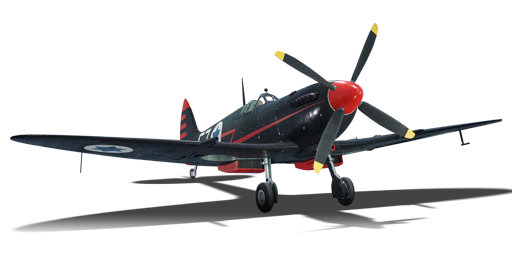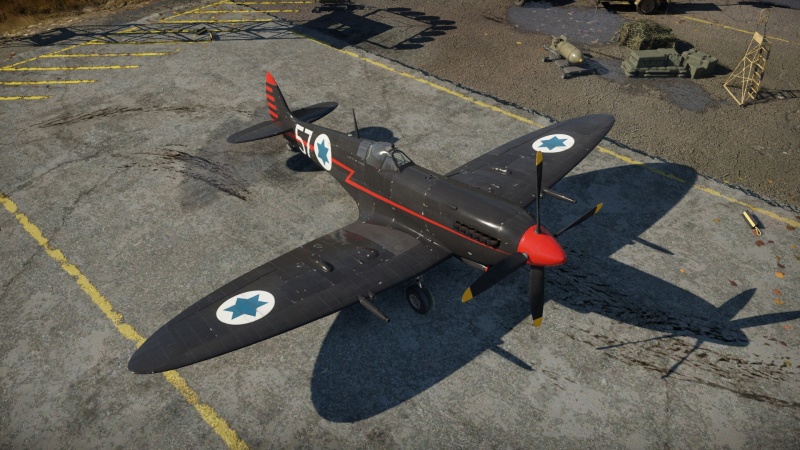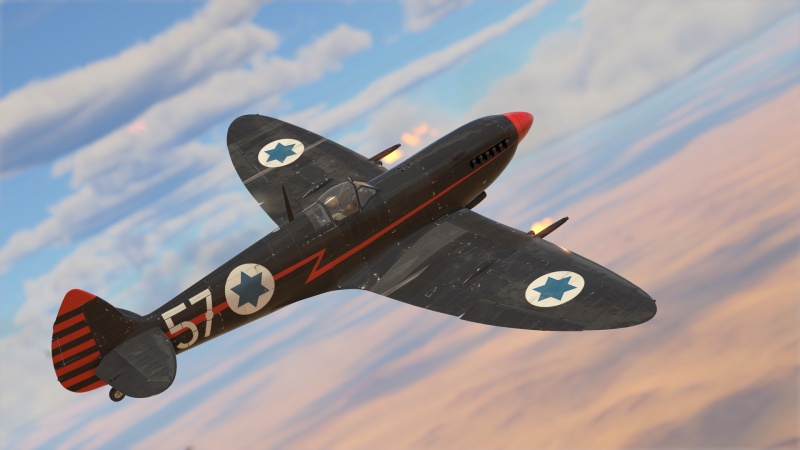Weizman's Spitfire LF Mk.IXe (Israel)
| This page is about the Israeli gift fighter Weizman's Spitfire LF Mk.IXe (Israel). For other versions, see Spitfire (Family). |
Contents
Description
Ezer Weizman's Spitfire LF Mk IXe is a premium gift rank IV Israeli fighter with a battle rating of 5.3 (AB), 5.7 (RB), and 5.0 (SB). It was introduced in Update "Ground Breaking".
General info
Flight performance
Describe how the aircraft behaves in the air. Speed, manoeuvrability, acceleration and allowable loads - these are the most important characteristics of the vehicle.
| Characteristics | Max Speed (km/h at _,___ m) |
Max altitude (metres) |
Turn time (seconds) |
Rate of climb (metres/second) |
Take-off run (metres) | |||
|---|---|---|---|---|---|---|---|---|
| AB | RB | AB | RB | AB | RB | |||
| Stock | 632 | 611 | 11500 | 16.4 | 17.0 | 22.2 | 22.2 | 320 |
| Upgraded | 735 | 690 | 14.8 | 14.8 | 43.3 | 31.8 | ||
Details
| Features | ||||
|---|---|---|---|---|
| Combat flaps | Take-off flaps | Landing flaps | Air brakes | Arrestor gear |
| X | X | ✓ | X | X |
| Limits | ||||||
|---|---|---|---|---|---|---|
| Wings (km/h) | Gear (km/h) | Flaps (km/h) | Max Static G | |||
| Combat | Take-off | Landing | + | - | ||
| 774 | 270 | N/A | N/A | 230 | ~10 | ~4 |
| Optimal velocities (km/h) | |||
|---|---|---|---|
| Ailerons | Rudder | Elevators | Radiator |
| < 321 | < 400 | < 350 | > 470 |
Survivability and armour
- 38 mm Bulletproof glass in the cockpit front.
- 4 mm Steel plate in the pilot's seat.
- 6-7 mm Steel plates behind the pilot.
- 3 mm Steel plate on top of the fuel tanks.
- 3 mm Steel boxes around the wing ammunition.
Modifications and economy
Armaments
Offensive armament
Weizman's Spitfire LF Mk.IXe (Israel) is armed with:
- 2 x 20 mm Hispano Mk.II cannons, wing-mounted (135 rpg = 270 total)
- 2 x 12.7 mm M2 Browning machine guns, wing-mounted (260 rpg = 520 total)
Suspended armament
Weizman's Spitfire LF Mk.IXe (Israel) can be outfitted with the following ordnance:
- Without load
- 16 x Flz.-Rakete Oerlikon rockets
- 2 x 250 lb AN-M57 bombs (500 lb total)
- 2 x 250 lb AN-M57 bombs + 16 x Flz.-Rakete Oerlikon rockets (500 lb total)
Usage in battles
Describe the tactics of playing in the aircraft, the features of using aircraft in a team and advice on tactics. Refrain from creating a "guide" - do not impose a single point of view, but instead, give the reader food for thought. Examine the most dangerous enemies and give recommendations on fighting them. If necessary, note the specifics of the game in different modes (AB, RB, SB).
Pros and cons
Summarise and briefly evaluate the vehicle in terms of its characteristics and combat effectiveness. Mark its pros and cons in the bulleted list. Try not to use more than 6 points for each of the characteristics. Avoid using categorical definitions such as "bad", "good" and the like - use substitutions with softer forms such as "inadequate" and "effective".
Pros:
- Fast climb rate
- Relatively versatile weapon presets available
- Insanely fast turn rate for its battle rating
- Superb ground strike ability for a fighter
Cons:
- Since it is an 'LF (low-altitude fighter)' Spitfire, this Spitfire's performance suffers at high altitude
History
Shortly after the establishment of the State of Israel, its new Defense Ministry began work on the formation of a more organised air force as a branch of the new Israel Defense Force. The first planes purchased were Czechoslovakian Avia S-199s - a partially-improvised version of the Bf 109 - but these proved to be inferior to Egyptian Air Force Spitfires. Simultaneously, Israel began acquiring its own Spitfires (primarily surplus planes previously given to Czechoslovakia by Britain) in a series of politically - and functionally - complex operations. By the end of the war, most combat aircraft in the Israeli Air Force (IAF) were Spitfires of whatever models could be acquired.
The Black Spitfire originally arrived in Israel in November 1949 (months after the official end of the war), and initially bore the number 2057. It served in the 101 fighter squadron. By this time, Spitfires were only used as bomber escorts and for reconnaissance flights. Most Israeli Spitfires were eventually sold to Burma in 1954; however, Ezer Wiezman - then commander of the Ramat David air force base - argued to keep several of the aircraft in Israel. He ordered one of those aircraft, including number 2057, to be painted black, to match the colour scheme used by his former British airbase commander in Rhodesia during World War II, when Weizman trained as a pilot in the RAF. The plane was renumbered to "57".
Weizman kept the aircraft for training purposes in the IAF, but it was unofficially understood to be his own personal plane. Weizman later became Commander of the IAF and eventually retired, but nevertheless kept flying the plane during multiple IAF air parades over the following decades. The plane became famous in Israel as "Weizman's Black Spit", and was closely associated with the man. Weizman went on to become a member of the Israeli parliament, its Minister of Defense, and finally the President of the State of Israel. During his funeral in 2005 the Black Spit was flown over the burial ceremony.
The Black Spit is one of about 60 Spitfires that are still operational today. When not undergoing maintenance, it is occasionally kept on public display at the IAF Museum near Be'er Sheva.
Media
Excellent additions to the article would be video guides, screenshots from the game, and photos.
See also
- Other late Merlin-engine LF variant Spitfires
External links
| Israel fighters | |
|---|---|
| Bf 109 | Sakeen |
| P-51 | P-51D-20-NA |
| Spitfires | Spitfire Mk IXc · Weizman's Spitfire LF Mk.IXe · Spitfire Mk.IX (CW) |
| Israel premium aircraft | |
|---|---|






